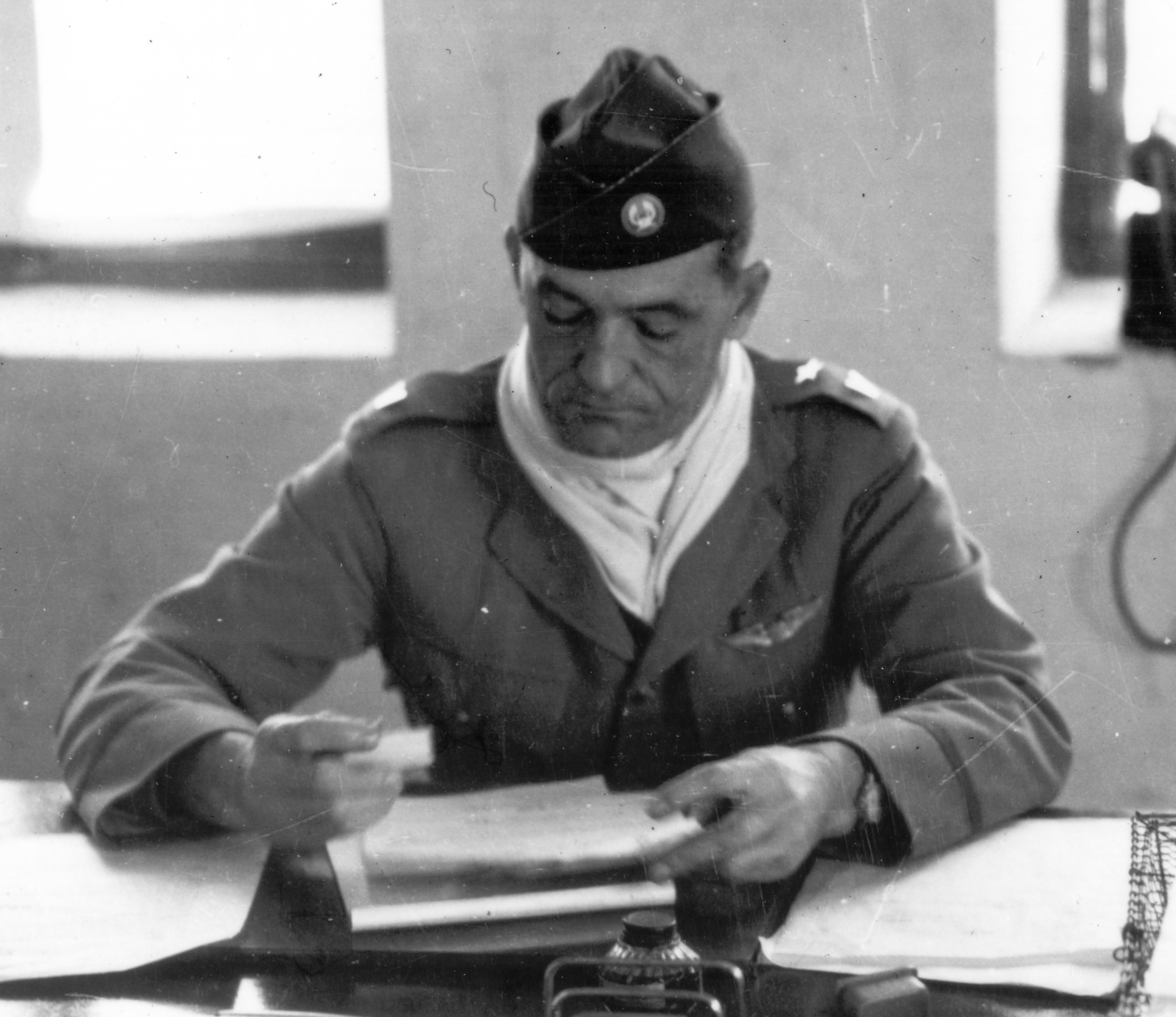|
Chinese-American Composite Wing (Provisional)
The Chinese-American Composite Wing (Provisional) (abbreviated CACW; zh, 中美空軍混合團) was a combined Chinese and American fighter and bomber unit that operated during World War II, from 1943 to 1945. The CACW was administratively part of the Fourteenth Air Force, United States Army Air Forces (USAAF), while its individual units were part of the Development of Chinese Nationalist air force (1937–1945), Chinese Nationalist Air Force. The wing and its component groups and squadrons were each led by an American officer who was assisted by a Chinese officer as the deputy commander, and the other personnel were a mix of Chinese and American pilots and ground crew. The CACW is also sometimes referred to as the "Flying Tigers," the famous nickname of the 1st American Volunteer Group that was disbanded in 1942, though they were separate units. The Fourteenth Air Force that the wing was part of was commanded by Claire Chennault, the founder of the original Flying Tigers. After ... [...More Info...] [...Related Items...] OR: [Wikipedia] [Google] [Baidu] |
Flying Tigers
The First American Volunteer Group (AVG) of the Republic of China Air Force, nicknamed the Flying Tigers, was formed to help oppose the Japanese invasion of China. Operating in 1941–1942, it was composed of pilots from the United States Army Air Corps (USAAC), United States Navy, Navy (USN), and United States Marine Corps, Marine Corps (USMC), and was commanded by Claire Lee Chennault. Their Curtiss P-40 Warhawk, Curtiss P-40B Warhawk aircraft, marked with Chinese colors, flew under American control. Recruited under President Franklin Roosevelt's authority before Attack on Pearl Harbor, Pearl Harbor, their mission was to bomb Japan and defend the Republic of China, but many delays meant the AVG first flew in combat after the US and Japan declared war. The group consisted of three fighter aircraft, fighter Squadron (aviation), squadrons of around 30 aircraft each that trained in Burma before the American entry into World War II to defend the Republic of China against Empire ... [...More Info...] [...Related Items...] OR: [Wikipedia] [Google] [Baidu] |
National Revolutionary Army
The National Revolutionary Army (NRA; zh, labels=no, t=國民革命軍) served as the military arm of the Kuomintang, Chinese Nationalist Party (Kuomintang, or KMT) from 1924 until 1947. From 1928, it functioned as the regular army, de facto national armed forces of the Nationalist government, Republic of China during the period of Nationalist rule. Following the promulgation of the Constitution of the Republic of China, 1947 Constitution — which established civilian control of the military, civilian control over the military on a de jure basis — it was formally reorganised as the Republic of China Armed Forces. Initially formed from Constitutional Protection Junta, pro-nationalist faction troops after 1917, with assistance from the Soviet Union, the NRA was created as an instrument for the Nationalist government to unify China during the Warlord Era. It went on to fight major military conflicts, including the Northern Expedition against the Beiyang warlords, the encirclem ... [...More Info...] [...Related Items...] OR: [Wikipedia] [Google] [Baidu] |
China Air Task Force
The China Air Task Force (CATF) was a combat organization of the United States Army Air Forces created in July 1942 under the command of Brig. Gen. Claire Chennault, after the Flying Tigers of the 1st American Volunteer Group of the Chinese Air Force were disbanded on 4 July of that year. It consisted of the 23rd Fighter Group with four squadrons, the assigned 74th, 75th, 76th, and attached 16th Fighter Squadrons, plus the 11th Bombardment Squadron. It was a subordinate unit of the Tenth Air Force in India, commanded by Brig. Gen. Earl Naiden and (from 18 August 1942) by Maj. Gen. Clayton Bissell. "Chennault had no respect for Bissell as a combat airman," wrote his biographer Martha Byrd, and "Bissell had no respect for Chennault as an administrator." Their relationship, she wrote, was ugly.Byrd, p. 169 On 19 March 1943, the CATF was disbanded and replaced by the Fourteenth Air Force, with Chennault, now a major general, in command. In the nine months of its existence, the Ch ... [...More Info...] [...Related Items...] OR: [Wikipedia] [Google] [Baidu] |
23rd Fighter Group
The 23rd Fighter Group (23 FG) is a United States Air Force unit. It is assigned to the 23rd Wing and stationed at Moody Air Force Base, Georgia. The 23rd Fighter Group was established in World War II as the 23rd Pursuit Group of the United States Army Air Forces (USAAF).Maurer, ''Combat Units'', p. 72 Redesignated the 23rd Fighter Group before its activation, the group was formed in China on 4 July 1942, as a component of the China Air Task Force and received a small cadre of volunteer personnel from the simultaneously disbanded 1st American Volunteer Group (AVG) – the " Flying Tigers" of the Chinese Air Force. To carry on the traditions and commemorate the history of the AVG, aircraft of the USAF 23rd Fighter Group carry the same "Shark Teeth" nose art of the AVG's Curtiss P-40 Warhawks, along with the "FT" (Flying Tiger) tail code. The 23rd Fighter Group's aircraft are the only United States Air Force aircraft currently authorized to carry this distinctive and hist ... [...More Info...] [...Related Items...] OR: [Wikipedia] [Google] [Baidu] |
Nationalist Government
The Nationalist government, officially the National Government of the Republic of China, refers to the government of the Republic of China (1912–1949), Republic of China from 1 July 1925 to 20 May 1948, led by the nationalist Kuomintang (KMT) party. Following the outbreak of the 1911 Revolution, Xinhai Revolution, revolutionary leader Sun Yat-sen was elected to be China's List of Presidents of the Republic of China, provisional president and founded the Provisional Government of the Republic of China (1912), Provisional Government of the Republic of China. To preserve national unity, Sun ceded the presidency to military strongman Yuan Shikai, who established the Beiyang government. After Empire of China (1915-1916), a failed attempt to install himself as Emperor of China, Yuan died in 1916, leaving a power vacuum which resulted in China being divided into several Warlord Era, warlord fiefs and rival governments. They were nominally Chinese reunification (1928), reunified in 1 ... [...More Info...] [...Related Items...] OR: [Wikipedia] [Google] [Baidu] |
United States Army Air Corps
The United States Army Air Corps (USAAC) was the aerial warfare service component of the United States Army between 1926 and 1941. After World War I, as early aviation became an increasingly important part of modern warfare, a philosophical rift developed between more traditional ground-based army personnel and those who felt that aircraft were being underutilized and that air operations were being stifled for political reasons unrelated to their effectiveness. The USAAC was renamed from the earlier United States Army Air Service on 2 July 1926, and was part of the larger United States Army. The Air Corps became the United States Army Air Forces (USAAF) on 20 June 1941, giving it greater autonomy from the Army's middle-level command structure. During World War II, although not an administrative echelon, the Air Corps (AC) remained as one of the combat arms of the Army until 1947, when it was legally abolished by legislation establishing the United States Department of the Air Fo ... [...More Info...] [...Related Items...] OR: [Wikipedia] [Google] [Baidu] |
Soviet Volunteer Group
The Soviet Volunteer Group was the volunteer part of the Soviet Air Forces sent to support the Republic of China during the Second Sino-Japanese War between 1937 and 1941. After the Marco Polo Bridge Incident, the Sino-Soviet Non-Aggression Pact was signed leading to considerable Soviet military assistance to China, including the volunteer squadrons. China paid for the support with raw materials. Background In the aftermath of the Wall Street crash of 1929 and the subsequent worldwide economic crisis, the Empire of Japan pursued an expansionist policy against its weakened neighbors in the Far East. On 18 September 1931, Japan staged the Mukden Incident using it as a pretext for its invasion of Chinese Manchuria. Japan went on to transform the north–east of China into a puppet state under the name of Manchukuo. In the plans of the Japanese general staff, Manchukuo was to serve as a stepping stone for the future conquest of the rest of China. Facing increasing pressure China s ... [...More Info...] [...Related Items...] OR: [Wikipedia] [Google] [Baidu] |
Yangtze River Valley
The Yangtze or Yangzi ( or ) is the longest river in Eurasia and the third-longest in the world. It rises at Jari Hill in the Tanggula Mountains of the Tibetan Plateau and flows including Dam Qu River the longest source of the Yangtze, in a generally easterly direction to the East China Sea. It is the fifth-largest primary river by discharge volume in the world. Its drainage basin comprises one-fifth of the land area of China, and is home to nearly one-third of the country's population. The Yangtze has played a major role in the history, culture, and economy of China The People's Republic of China is a Developing country, developing Mixed economy, mixed socialist market economy, incorporating Industrial policy, industrial policies and strategic Five-year plans of China, five-year plans. —Xu, Chenggang. "T .... For thousands of years, the river has been used for water, irrigation, sanitation, transportation, industry, boundary-marking, and war. The Yangtze Delta ... [...More Info...] [...Related Items...] OR: [Wikipedia] [Google] [Baidu] |
Battle Of Shanghai
The Battle of Shanghai ( zh, t=淞滬會戰, s=淞沪会战, first=t, p=Sōng hù huìzhàn) was a major battle fought between the Empire of Japan and the Republic of China (1912–1949), Republic of China in the Chinese city of Shanghai during the Second Sino-Japanese War. It lasted from August 13, 1937, to November 26, 1937, and was arguably the single largest and longest battle of the entire war, with it even regarded by some historians as the first battle of World War II. It resulted in the Japanese capture of the city and heavy destruction to the city. It was the first of the twenty-two major engagements fought between the National Revolutionary Army (NRA) of the Republic of China (1912–1949), Republic of China (ROC) and the Imperial Japanese Army (IJA) of the Empire of Japan at the beginning of the Second Sino-Japanese War. The Japanese eventually prevailed after over three months of extensive fighting on land, in the air and at sea. Both sides accused each other of using ... [...More Info...] [...Related Items...] OR: [Wikipedia] [Google] [Baidu] |
Nationalist Government
The Nationalist government, officially the National Government of the Republic of China, refers to the government of the Republic of China (1912–1949), Republic of China from 1 July 1925 to 20 May 1948, led by the nationalist Kuomintang (KMT) party. Following the outbreak of the 1911 Revolution, Xinhai Revolution, revolutionary leader Sun Yat-sen was elected to be China's List of Presidents of the Republic of China, provisional president and founded the Provisional Government of the Republic of China (1912), Provisional Government of the Republic of China. To preserve national unity, Sun ceded the presidency to military strongman Yuan Shikai, who established the Beiyang government. After Empire of China (1915-1916), a failed attempt to install himself as Emperor of China, Yuan died in 1916, leaving a power vacuum which resulted in China being divided into several Warlord Era, warlord fiefs and rival governments. They were nominally Chinese reunification (1928), reunified in 1 ... [...More Info...] [...Related Items...] OR: [Wikipedia] [Google] [Baidu] |





